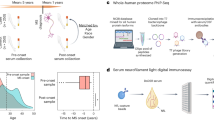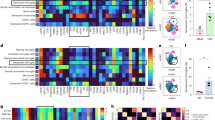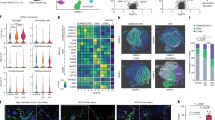Abstract
Alzheimer’s disease (AD) is characterized by deposition of amyloid-β (Aβ) plaques and neurofibrillary tangles in the brain, accompanied by synaptic dysfunction and neurodegeneration. Antibody-based immunotherapy against Aβ to trigger its clearance or mitigate its neurotoxicity has so far been unsuccessful. Here we report the generation of aducanumab, a human monoclonal antibody that selectively targets aggregated Aβ. In a transgenic mouse model of AD, aducanumab is shown to enter the brain, bind parenchymal Aβ, and reduce soluble and insoluble Aβ in a dose-dependent manner. In patients with prodromal or mild AD, one year of monthly intravenous infusions of aducanumab reduces brain Aβ in a dose- and time-dependent manner. This is accompanied by a slowing of clinical decline measured by Clinical Dementia Rating—Sum of Boxes and Mini Mental State Examination scores. The main safety and tolerability findings are amyloid-related imaging abnormalities. These results justify further development of aducanumab for the treatment of AD. Should the slowing of clinical decline be confirmed in ongoing phase 3 clinical trials, it would provide compelling support for the amyloid hypothesis.
This is a preview of subscription content, access via your institution
Access options
Subscribe to this journal
Receive 51 print issues and online access
$199.00 per year
only $3.90 per issue
Buy this article
- Purchase on Springer Link
- Instant access to full article PDF
Prices may be subject to local taxes which are calculated during checkout





Similar content being viewed by others
References
Hardy, J. & Selkoe, D. J. The amyloid hypothesis of Alzheimer’s disease: progress and problems on the road to therapeutics. Science 297, 353–356 (2002)
Hardy, J. A. & Higgins, G. A. Alzheimer’s disease: the amyloid cascade hypothesis. Science 256, 184–185 (1992)
Ising, C., Stanley, M. & Holtzman, D. M. Current thinking on the mechanistic basis of Alzheimer’s and implications for drug development. Clin. Pharmacol. Ther. 98, 469–471 (2015)
Selkoe, D. J. The therapeutics of Alzheimer’s disease: where we stand and where we are heading. Ann. Neurol. 74, 328–336 (2013)
Cummings, J. L., Morstorf, T. & Zhong, K. Alzheimer’s disease drug-development pipeline: few candidates, frequent failures. Alzheimers Res. Ther. 6, 37 (2014)
Doody, R. S. et al. Phase 3 trials of solanezumab for mild-to-moderate Alzheimer’s disease. N. Engl. J. Med. 370, 311–321 (2014)
Salloway, S. et al. Two phase 3 trials of bapineuzumab in mild-to-moderate Alzheimer’s disease. N. Engl. J. Med. 370, 322–333 (2014)
Ferrero, J. et al. First-in-human, double-blind, placebo-controlled, single-dose escalation study of aducanumab (BIIB037) in mild-to-moderate Alzheimer’s disease. Alzheimers Dement (N Y) (in the press)
Sevigny, J. et al. Amyloid PET screening for enrichment of early-stage Alzheimer disease clinical trials: experience in a phase 1b clinical trial. Alzheimer Dis. Assoc. Disord. 30, 1–7 (2016)
Landau, S. M. et al. Amyloid-β imaging with Pittsburgh compound B and florbetapir: comparing radiotracers and quantification methods. J. Nucl. Med. 54, 70–77 (2013)
Banks, W. A. et al. Passage of amyloid beta protein antibody across the blood-brain barrier in a mouse model of Alzheimer’s disease. Peptides 23, 2223–2226 (2002)
Levites, Y. et al. Insights into the mechanisms of action of anti-Abeta antibodies in Alzheimer’s disease mouse models. FASEB J. 20, 2576–2578 (2006)
Bard, F. et al. Peripherally administered antibodies against amyloid beta-peptide enter the central nervous system and reduce pathology in a mouse model of Alzheimer disease. Nat. Med. 6, 916–919 (2000)
Bohrmann, B. et al. Gantenerumab: a novel human anti-Aβ antibody demonstrates sustained cerebral amyloid-β binding and elicits cell-mediated removal of human amyloid-β. J. Alzheimers Dis. 28, 49–69 (2012)
Villemagne, V. L. et al. Amyloid β deposition, neurodegeneration, and cognitive decline in sporadic Alzheimer’s disease: a prospective cohort study. Lancet Neurol. 12, 357–367 (2013)
Ostrowitzki, S. et al. Mechanism of amyloid removal in patients with Alzheimer disease treated with gantenerumab. Arch. Neurol. 69, 198–207 (2012)
Sperling, R. et al. Amyloid-related imaging abnormalities in patients with Alzheimer’s disease treated with bapineuzumab: a retrospective analysis. Lancet Neurol. 11, 241–249 (2012)
Sperling, R. A. et al. Amyloid-related imaging abnormalities in amyloid-modifying therapeutic trials: recommendations from the Alzheimer’s Association Research Roundtable Workgroup. Alzheimers Dement. 7, 367–385 (2011)
Barakos, J. et al. MR imaging features of amyloid-related imaging abnormalities. AJNR Am. J. Neuroradiol. 34, 1958–1965 (2013)
Zago, W. et al. Vascular alterations in PDAPP mice after anti-Aβ immunotherapy: Implications for amyloid-related imaging abnormalities. Alzheimers Dement. 9 (Suppl), S105–S115 (2013)
Wang, A., Das, P., Switzer, R. C., III, Golde, T. E. & Jankowsky, J. L. Robust amyloid clearance in a mouse model of Alzheimer’s disease provides novel insights into the mechanism of amyloid-beta immunotherapy. J. Neurosci. 31, 4124–4136 (2011)
Boche, D. et al. Consequence of Abeta immunization on the vasculature of human Alzheimer’s disease brain. Brain 131, 3299–3310 (2008)
Haass, C. & Selkoe, D. J. Soluble protein oligomers in neurodegeneration: lessons from the Alzheimer’s amyloid beta-peptide. Nat. Rev. Mol. Cell Biol. 8, 101–112 (2007)
Kayed, R. & Lasagna-Reeves, C. A. Molecular mechanisms of amyloid oligomers toxicity. J. Alzheimers Dis. 33 (Suppl 1), S67–S78 (2013)
Benilova, I., Karran, E. & De Strooper, B. The toxic Aβ oligomer and Alzheimer’s disease: an emperor in need of clothes. Nat. Neurosci. 15, 349–357 (2012)
Koffie, R. M. et al. Oligomeric amyloid beta associates with postsynaptic densities and correlates with excitatory synapse loss near senile plaques. Proc. Natl Acad. Sci. USA 106, 4012–4017 (2009)
Shankar, G. M. et al. Amyloid-beta protein dimers isolated directly from Alzheimer’s brains impair synaptic plasticity and memory. Nat. Med. 14, 837–842 (2008)
Condello, C., Yuan, P., Schain, A. & Grutzendler, J. Microglia constitute a barrier that prevents neurotoxic protofibrillar Aβ42 hotspots around plaques. Nat. Commun. 6, 6176 (2015)
Jin, M. et al. Soluble amyloid beta-protein dimers isolated from Alzheimer cortex directly induce tau hyperphosphorylation and neuritic degeneration. Proc. Natl Acad. Sci. USA 108, 5819–5824 (2011)
Kastanenka, K. et al. Amelioration of calcium dyshomeostasis by immunotherapy with BIIB037 in Tg2576 mice. Alzheimers Dement. 9, P508 (2013)
Jarosz-Griffiths, H. H., Noble, E., Rushworth, J. V. & Hooper, N. M. Amyloid-β receptors: the good, the bad, and the prion protein. J. Biol. Chem. 291, 3174–3183 (2016)
Morkuniene, R. et al. Small Aβ1-42 oligomer-induced membrane depolarization of neuronal and microglial cells: role of N-methyl-d-aspartate receptors. J. Neurosci. Res. 93, 475–486 (2015)
Um, J. W. et al. Metabotropic glutamate receptor 5 is a coreceptor for Alzheimer aβ oligomer bound to cellular prion protein. Neuron 79, 887–902 (2013)
Derby, C. A. et al. Screening for predementia AD: time-dependent operating characteristics of episodic memory tests. Neurology 80, 1307–1314 (2013)
Dubois, B. et al. Revising the definition of Alzheimer’s disease: a new lexicon. Lancet Neurol. 9, 1118–1127 (2010)
McKhann, G. M. et al. The diagnosis of dementia due to Alzheimer’s disease: recommendations from the National Institute on Aging-Alzheimer’s Association workgroups on diagnostic guidelines for Alzheimer’s disease. Alzheimers Dement. 7, 263–269 (2011)
Eli Lilly and Company. Amyvid Prescribing Information. http://www.lilly.com. (2013)
Clark, C. M. et al. Cerebral PET with florbetapir compared with neuropathology at autopsy for detection of neuritic amyloid-β plaques: a prospective cohort study. Lancet Neurol. 11, 669–678 (2012)
Hock, C. et al. Generation of antibodies specific for beta-amyloid by vaccination of patients with Alzheimer disease. Nat. Med. 8, 1270–1275 (2002)
Tao, M. H. & Morrison, S. L. Studies of aglycosylated chimeric mouse-human IgG. Role of carbohydrate in the structure and effector functions mediated by the human IgG constant region. J. Immunol. 143, 2595–2601 (1989)
Johnson-Wood, K. et al. Amyloid precursor protein processing and A beta42 deposition in a transgenic mouse model of Alzheimer disease. Proc. Natl Acad. Sci. USA 94, 1550–1555 (1997)
Acknowledgements
These studies were funded by Biogen. The authors thank the patients and their family members participating in the aducanumab studies, and the PRIME investigators (Supplementary Information) and staff conducting these studies. Medical writing support, under direction of the authors, was provided by A. Smith at Complete Medical Communications, and was funded by Biogen. We thank N. Pederson, J. Dolnikova and E. Garber for help in generating the recombinant antibodies, D. Fahrer, C. Quigley, M. Themeles, X. Zhang and P. Auluck for help in generating the histological data, and K. Mack for editorial support and coordination of the authors in combining the preclinical and clinical work in this manuscript.
Author information
Authors and Affiliations
Contributions
T.B., P.H.W., M.M., T.E., K.R., J.G. and R.M.N. designed the preclinical studies, and J.S., Y.L., J.G., J.F., C.H., R.M.N. and A.S. designed the clinical study. P.C. led the imaging implementation for the clinical study. T.C. and J.O. were clinical study statisticians. T.B., P.H.W., M.M., R.D., F.Q., M.A., M.L., S.C., M.S.B., O.Q.-M., R.H.S., H.M.A., T.E., J.G. and R.M.N. generated, analysed, and/or interpreted data from preclinical studies. T.B., P.H.W., M.M., R.D., F.Q., M.A., M.L., S.C., M.S.B., O.Q.-M., R.H.S., H.M.A., T.E., K.R., J.G., C.H., R.M.N. and A.S. critically reviewed preclinical sections of the manuscript. J.S., P.C., L.W., S.S., T.C., Y.L., J.O., J.F., Y.H., A.M., J.G., C.H., R.M.N. and A.S. analysed and interpreted clinical study data and critically reviewed clinical sections of the manuscript. All authors approved the final version of the manuscript for submission. Biogen and Neurimmune reviewed and provided feedback on the paper. The authors had full editorial control of the paper, and provided their final approval of all content.
Corresponding author
Ethics declarations
Competing interests
J.S., P.C., T.B., P.H.W., L.W., R.D., T.C., Y.L., J.O., F.Q., M.A., M.L., S.C., M.S.B., O.Q.-M., R.H.S., H.M.A., T.E., K.R., J.F., Y.H., A.M. and A.S. are current or former employees and/or shareholders of Biogen. J.S. is an employee of F. Hoffmann-La Roche Ltd., Basel, Switzerland; R.D. is an employee of AbbVie Inc., Worcester, Massachusetts, USA; M.A. is an employee of Substantial Living, San Francisco, California, USA; M.L. is an employee of Novartis, Cambridge, Massachusetts, USA; S.C. is an employee of SynteractHCR, Carlsbad, California, USA; O.Q.-M. is an employee of Shire, Lexington, Massachusetts, USA; R.H.S. and K.R. are employees of Yumanity Therapeutics, Cambridge, Massachusetts, USA; T.E. is an employee of Takeda Pharmaceuticals, Cambridge, Massachusetts, USA; J.F. is retired. M.M., J.G., C.H. and R.M.N. are employees and shareholders of Neurimmune. S.S. was a site investigator for the PRIME study and received consultation fees from Biogen, and has received research support from Functional Neuromodulation, Merck, Genentech, Roche, Lilly, and Avid Radiopharmaceuticals, and consultation fees from Merck, Piramal, Lilly, Genentech, and Roche. He owns no stock options or royalties. Biogen has filed and licensed certain patent applications pertaining to Aducanumab.
Additional information
Reviewer Information Nature thanks L. Lannfelt, R. Thomas and the other anonymous reviewer(s) for their contribution to the peer review of this work.
Extended data figures and tables
Extended Data Figure 1 Participant accounting.
PET, positron emission tomography.
Extended Data Figure 2 Amyloid plaque reduction with aducanumab by baseline clinical stage and baseline ApoE ε4 status.
a, b, Analyses by baseline clinical stage were performed using ANCOVA for change from baseline with factors of: treatment, ApoE ε4 status (carrier and non-carrier) and baseline composite SUVR (a), and for analyses by ApoE ε4 status, using treatment and baseline composite SUVR (b). Adjusted mean ± s.e. ApoE ε4, apolipoprotein E ε4 allele; SUVR, standard uptake value ratio.
Extended Data Figure 3 Amyloid plaque reduction: regional analysis SUVR at week 54.
The boxed area indicates the six regions included in the composite score. *P < 0.05; **P < 0.01; ***P < 0.001 versus placebo; two-sided tests with no adjustments for multiple comparisons. Adjusted mean ± s.e. Analyses using ANCOVA. SUVR, standard uptake value ratio.
Extended Data Figure 4 Brain penetration of aducanumab after a single intraperitoneal administration in 22-month-old Tg2576 transgenic mice.
a, b, Aducanumab levels in plasma and brain (a), and plasma Aβ levels after a single dose (b; n = 4–5; mean ± s.e.). c, d, In vivo binding of aducanumab to amyloid deposits detected using a human IgG-specific secondary antibody (c), and ex vivo immunostaining with a pan-Aβ antibody on consecutive section (d). Examples of a compact Aβ plaque (solid arrow), diffuse Aβ deposit (dashed arrow), and CAA lesion (dotted arrow). CAA, cerebral amyloid angiopathy.
Extended Data Figure 5 Exposure following weekly dosing with chaducanumab in 9.5- to 15.5-month-old Tg2576 transgenic mice.
a, b, chaducanumab concentrations in plasma (a), or DEA-soluble brain extract (b) were measured in samples collected 24 h after the last dose in the ‘Chronic efficacy study’. Mean ± s.e. Dotted lines represent the limits of quantitation of each assay. c, Correlations of drug concentrations in plasma (open circles) or brain (open triangles) with administered dose. The average brain concentrations in the two groups receiving the lowest dose were below the limit of quantitation for that assay, which is indicated by a dotted line on the figure.
Extended Data Figure 6 Treatment with chaducanumab affects plaques of all sizes.
a, Following weekly dosing of chaducanumab in Tg2576 from 9.5–15.5 months of age, amyloid plaques were stained with 6E10 and quantified using Visiopharm software. b, Plaque size was defined by area, and coloured as follows: <125 μm2 (cyan), 125–250 μm2 (green), 250–500 μm2 (pink), and >500 μm2 (red). c, chaducanumab treatment was associated with a significant decrease in plaque number in all size ranges relative to vehicle-treated controls, with reductions of 58%, 68%, 68%, and 53% in the number of plaques for the <125 μm2, 125–250 μm2, 250–500 μm2, and >500 μm2 groups size, respectively. Mean ± s.e.; statistically significant differences from vehicle for each size range are indicated with asterisks; *P < 0.05, Mann–Whitney test.
Extended Data Figure 7 Enhanced recruitment of microglia to amyloid plaques following chaducanumab treatment and engagement of Fcγ receptors.
a, b, Brain sections from either PBS- or chaducanumab-treated mice (‘Chronic efficacy study’; 3 mg kg−1 group) were immunostained for Aβ (6E10; red) and a marker of microglia (Iba1; brown). c, The area of individual amyloid plaques was measured, and Iba1-stained microglia were grouped into two categories, either associated with plaques (within 25 μm of a plaque) or not associated with plaques (>25 μm from a plaque). Plaques with circumferences ≥ 70% surrounded by microglia were quantified and stratified based on plaque size. The fraction of plaques that were at least 70% surrounded by microglia was significantly greater in the chaducanumab-treated group (white bars) compared with the PBS control group (grey bars), for plaques ≥250 μm2. Mean ± s.e.; statistically significant differences from vehicle for each size range are indicated with asterisks; *P < 0.05, Bonferroni’s post hoc test following one-way analysis of variance. All quantifications were done using the Visiopharm software. d, e, FITC-labelled Aβ42 fibrils were incubated with different concentrations of the antibodies before adding to BV-2 microglia cell line (d), or primary microglia (e) for phagocytosis experiment measuring uptake of Aβ42 fibrils into the cells by FACS analysis. Mean ± s.d.
Supplementary information
Supplementary Information
This includes Supplementary Methods, a Supplementary Discussion and Results, and a list of the PRIME investigators. (PDF 249 kb)
Rights and permissions
About this article
Cite this article
Sevigny, J., Chiao, P., Bussière, T. et al. The antibody aducanumab reduces Aβ plaques in Alzheimer’s disease. Nature 537, 50–56 (2016). https://doi.org/10.1038/nature19323
Received:
Accepted:
Published:
Issue Date:
DOI: https://doi.org/10.1038/nature19323
This article is cited by
-
A single-domain antibody detects and neutralises toxic Aβ42 oligomers in the Alzheimer’s disease CSF
Alzheimer's Research & Therapy (2024)
-
Protocol for a single-arm, pilot trial of creatine monohydrate supplementation in patients with Alzheimer’s disease
Pilot and Feasibility Studies (2024)
-
Histone deacetylase inhibitors VPA and WT161 ameliorate the pathological features and cognitive impairments of the APP/PS1 Alzheimer’s disease mouse model by regulating the expression of APP secretases
Alzheimer's Research & Therapy (2024)
-
Amyloid-β aggregates activate peripheral monocytes in mild cognitive impairment
Nature Communications (2024)
-
Molecular dynamics simulations to explore the binding mode between the amyloid-β protein precursor (APP) and adaptor protein Mint2
Scientific Reports (2024)
Comments
By submitting a comment you agree to abide by our Terms and Community Guidelines. If you find something abusive or that does not comply with our terms or guidelines please flag it as inappropriate.



